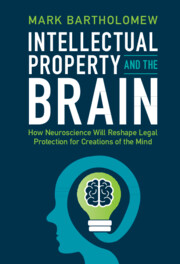 Intellectual Property and the Brain
Intellectual Property and the Brain Book contents
- Intellectual Property and the Brain
- Intellectual Property and the Brain
- Copyright page
- Contents
- List of Figures
- Acknowledgments
- Introduction
- Part I The Law and Neuroscience of Creative Activity
- Part II Understanding Audiences for Art and Advertising
- Part III Using Neuroscience to Improve Intellectual Property Law
- 6 How to Take Creativity Seriously
- 7 Know Your Audience
- 8 Advertising, Fast and Slow
- Conclusion
- Index
8 - Advertising, Fast and Slow
from Part III - Using Neuroscience to Improve Intellectual Property Law
Published online by Cambridge University Press: 14 July 2022
- Intellectual Property and the Brain
- Intellectual Property and the Brain
- Copyright page
- Contents
- List of Figures
- Acknowledgments
- Introduction
- Part I The Law and Neuroscience of Creative Activity
- Part II Understanding Audiences for Art and Advertising
- Part III Using Neuroscience to Improve Intellectual Property Law
- 6 How to Take Creativity Seriously
- 7 Know Your Audience
- 8 Advertising, Fast and Slow
- Conclusion
- Index
Summary
Courts and scholars need to be judicious in translating the lessons of consumer neuroscience into new trademark doctrine. The chapter begins by cautioning against the motivated use of science in the courtroom, using the introduction of trademark survey evidence from trained psychologists in the early 1900s as a cautionary tale. Psychologists recognize two models of consumer reasoning: an automatic, emotional model and a deliberative, cognitive model. Neuroscience offers a window into both processes, but courts should be wary of admitting evidence purporting to measure non-deliberative changes in mark meaning. Trademark law has historically limited its remit to the informational components of advertising, in part because changes in a brand’s emotional meaning have been difficult to calculate. Neuroscientific evidence of these changes may now be available, but using them to decide trademark cases could lead to anti-competitive outcomes.
- Type
- Chapter
- Information
- Intellectual Property and the BrainHow Neuroscience Will Reshape Legal Protection for Creations of the Mind, pp. 168 - 186Publisher: Cambridge University PressPrint publication year: 2022
